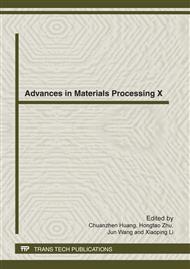p.111
p.117
p.123
p.128
p.134
p.140
p.146
p.152
p.157
Influence of Inclination Angle on Machined Surface Hardness in High Speed Ball End Milling
Abstract:
In this paper, the effects of the variational combinations of cutter inclination angle in feed direction and the feed per tooth on the machined surface hardness were mainly concerned. The cutting forces transformed from the measured cutting forces in OXYZ and the SEM microstructures of the surface layer were analyzed to explore the generation condition of the hardness. Variations of the surface hardness are not apparent with the increment of feed per tooth with the identical other cutting parameters. Inclination angles in feed direction of approximately ranging from 10° to 15° and from 25° to 30°, which correspond to high surface hardness, are suggested to be applied in cutting process when high abrasive resistance is expected. While values of inclination angle approximately equal to 0° and 45° are prior to be chosen when high shock resistance performance is firstly expected. Optimization of the cutting parameters, which could offer guidance to the machining of sculptured surface concerning cutter inclination angle, was presented.
Info:
Periodical:
Pages:
134-139
Citation:
Online since:
April 2012
Authors:
Price:
Сopyright:
© 2012 Trans Tech Publications Ltd. All Rights Reserved
Share:
Citation:


